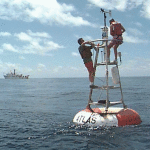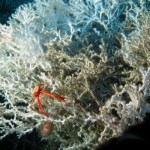
Growing up to two meters (six feet) long, Humboldt squid are formidable predators that hunt krill and a variety of fishes. Their normal habitat is within the tropical and subtropical waters of the East Pacific. Over the last few years, however, Humboldt squid have begun moving into cooler-water areas such as Central California.
Image: (c) 2003 MBARI
If you been keeping up here at DSN, you probably already know that Humboldt squid are invading further north up the Pacific Coast. Dosidicus gigas are voracious pack hunters occurring historically from Chile to Baja California. Occasionally, they are reported as far north as San Francisco and in the last few years strandings of Humboldts as far north as BC have occurred. Mass strandings are a common occurrence in Southern California. This may sound cool…who doesn’t love a big squid in their backyards? The problem is they may be decimating populations of Pacific hake, an important commercial fish. The culprit for the squid’s advances…no not global warming…overfishing. “Ironically, these squid may have benefited from the decline of large tuna and billfish in the Equatorial Pacific, which previously preyed upon and competed with the Humboldt squid for food.”
The first scientific documentation of the pattern and potential underlying mechanisms occurs in a fascinating study from Louis Zeidberg, formerly of MBARI and now at Hopkins Marine Lab, and Bruce Robison and published in PNAS.
The study relies on MBARi’s video archive from ROV dives, spanning back to 1989, to document the Humboldt in Monterey Bay. Ziedberg and Robison found “no observations of Humboldt Squid from 1989 to 1997. During 1997, however, large numbers of Humboldt squid were seen for a year or two after a strong El Nino event brought warm water northward along the coast and into Monterey Bay. From 1999 until 2002, just a few Humboldt squid were seen during ROV dives. In 2002, however, large numbers of squid appeared after a mild El Nino event, and they have been abundant ever since.”
The authors hypothesize that El Nino driven currents carry Humboldts northward to new feeding areas but they die out quickly. However since 2002, populations have rooted in the bay potentially reflecting a decrease in the number of predators and competitors such as large tunas and billfish. The study further demonstrates a reduction in hake within a month after Humboldt squid increased in Monterey Bay.





